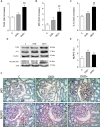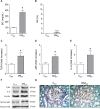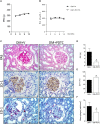NF-κB System Is Chronically Activated and Promotes Glomerular Injury in Experimental Type 1 Diabetic Kidney Disease
- PMID: 32116790
- PMCID: PMC7026681
- DOI: 10.3389/fphys.2020.00084
NF-κB System Is Chronically Activated and Promotes Glomerular Injury in Experimental Type 1 Diabetic Kidney Disease
Abstract
High glucose concentration can activate TLR4 and NF-κB, triggering the production of proinflammatory mediators. We investigated whether the NF-κB pathway is involved in the pathogenesis and progression of experimental diabetic kidney disease (DKD) in a model of long-term type 1 diabetes mellitus (DM). Adult male Munich-Wistar rats underwent DM by a single streptozotocin injection, and were kept moderately hyperglycemic by daily insulin injections. After 12 months, two subgroups - progressors and non-progressors - could be formed based on the degree of glomerulosclerosis. Only progressors exhibited renal TLR4, NF-κB and IL-6 activation. This scenario was already present in rats with short-term DM (2 months), at a time when no overt glomerulosclerosis can be detected. Chronic treatment with the NF-κB inhibitor, pyrrolidine dithiocarbamate (PDTC), prevented activation of renal TLR4, NF-κB or IL-6, without interfering with blood glucose. PDTC prevented the development of glomerular injury/inflammation and oxidative stress in DM rats. In addition, the NF-κB p65 component was detected in sclerotic glomeruli and inflamed interstitial areas in biopsy material from patients with type 1 DM. These observations indicate that the renal NF-κB pathway plays a key role in the development and progression of experimental DKD, and can become an important therapeutic target in the quest to prevent the progression of human DKD.
Keywords: NF-κB; diabetic kidney disease; glomerulosclerosis; innate immunity; pyrrolidine dithiocarbamate.
Copyright © 2020 Foresto-Neto, Albino, Arias, Faustino, Zambom, Cenedeze, Elias, Malheiros, Camara, Fujihara and Zatz.
Figures








References
-
- Arias S. C., Valente C. P., Machado F. G., Fanelli C., Origassa C. S., de Brito T., et al. (2013). Regression of albuminuria and hypertension and arrest of severe renal injury by a losartan-hydrochlorothiazide association in a model of very advanced nephropathy. PLoS One 8:e56215. 10.1371/journal.pone.0056215 - DOI - PMC - PubMed
-
- Doi T., Vlassara H., Kirstein M., Yamada Y., Striker G. E., Striker L. J., et al. (1992). Receptor-specific increase in extracellular matrix production in mouse mesangial cells by advanced glycosylation end products is mediated via platelet-derived growth factor. Proc. Natl. Acad. Sci. U.S.A. 89 2873–2877. 10.1073/pnas.89.7.2873 - DOI - PMC - PubMed
-
- Faustino V. D., Arias S. C. A., Ávila V. F., Foresto-Neto O., Zambom F. F. F., Machado F. G., et al. (2018). Simultaneous activation of innate and adaptive immunity participates in the development of renal injury in a model of heavy proteinuria. Biosci. Rep. 38:BSR20180762. 10.1042/BSR20180762 - DOI - PMC - PubMed
LinkOut - more resources
Full Text Sources

